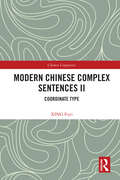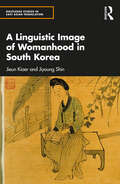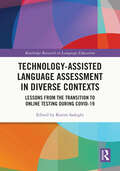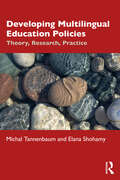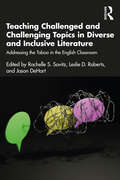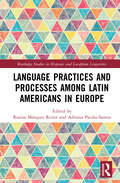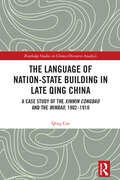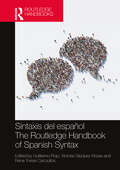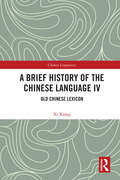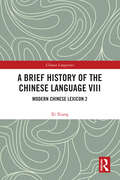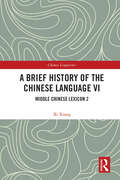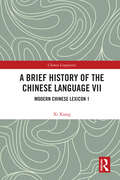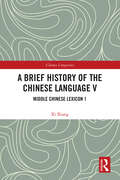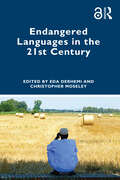- Table View
- List View
Modern Chinese Complex Sentences II: Coordinate Type (Chinese Linguistics)
by XING FuyiThis book is the second volume of a four-volume set on modern Chinese complex sentences, with a focus on coordinate complex sentences and their relevant forms.Complex sentences in modern Chinese are unique in formation and meaning. The author proposes a tripartite classification of Chinese complex sentences according to the semantic relationships between the clauses, that is, coordinate, causal, and adversative. This volume analyzes the coordinated type in the broad sense and the relevant forms, including the representative form in which the clauses are juxtaposed with each other, paired and single occurrences of the connective yībiān, and various forms of successive, progressive, and alternative complex sentences, as well as the compound forms.The book will be a useful reference for scholars and learners interested in Chinese grammar and language information processing.
A Linguistic Image of Womanhood in South Korea (Routledge Studies In East Asian Translation Ser.)
by Jieun Kiaer Jiyoung ShinA Linguistic Image of Womanhood in South Korea examines the verbal and non-verbal techniques used by contemporary South Korean women to navigate their society. South Korea is extremely hierarchical, and this is expressed through a complex array of different politeness levels in words, gestures, and behaviours. These hierarchies were formed over 500 years ago with the introduction of Neo-Confucianism from China, but patriarchal and paternalistic values still linger in contemporary Korean society. In this book, the authors have coined the term ‘language cosmetics’ to describe how women in South Korea modify their language and behaviour to conform to social expectations. The book examines womanhood and femininity as seen in popular Korean films, K-dramas, and K-pop. The authors note that feminine language and behaviour are not limited to women (as seen by the practice of aegyo or ‘acting cute’ within Korean boy bands), and they describe the tensions between gender hierarchy and socioeconomic status (as seen in the powerful and elegant samonim ladies of K-drama). This book will be informative for those studying and researching in the fields of Asian studies, cultural studies, linguistics, and East Asian languages, particularly those analysing how society and gender have an impact upon language.
A Linguistic Image of Womanhood in South Korea (Routledge Studies In East Asian Translation Ser.)
by Jieun Kiaer Jiyoung ShinA Linguistic Image of Womanhood in South Korea examines the verbal and non-verbal techniques used by contemporary South Korean women to navigate their society. South Korea is extremely hierarchical, and this is expressed through a complex array of different politeness levels in words, gestures, and behaviours. These hierarchies were formed over 500 years ago with the introduction of Neo-Confucianism from China, but patriarchal and paternalistic values still linger in contemporary Korean society. In this book, the authors have coined the term ‘language cosmetics’ to describe how women in South Korea modify their language and behaviour to conform to social expectations. The book examines womanhood and femininity as seen in popular Korean films, K-dramas, and K-pop. The authors note that feminine language and behaviour are not limited to women (as seen by the practice of aegyo or ‘acting cute’ within Korean boy bands), and they describe the tensions between gender hierarchy and socioeconomic status (as seen in the powerful and elegant samonim ladies of K-drama). This book will be informative for those studying and researching in the fields of Asian studies, cultural studies, linguistics, and East Asian languages, particularly those analysing how society and gender have an impact upon language.
Technology-Assisted Language Assessment in Diverse Contexts: Lessons from the Transition to Online Testing during COVID-19 (Routledge Research in Language Education)
by Karim SadeghiThis timely collection explores the role of digital technology in language education and assessment during the COVID-19 pandemic. It recognises the unique pressures which the COVID-19 pandemic placed on assessment in language education, and examines the forced shift in assessment strategies to go online, the existing shortfalls, as well as unique affordances of technology-assisted L2 assessment. By showcasing international examples of successful digital and computer-assisted proficiency and skills testing, the volume addresses theoretical and practical concerns relating to test validity, reliability, ethics, and student experience in a range of testing contexts. Particular attention is given to identifying lessons and implications for future research and practice, and the challenges of implementing unplanned computer-assisted language assessment during a crisis. Insightfully unpacking the ‘lessons learned’ from COVID and its impact on the acceleration of the shift towards online course and assessment delivery, it offers important guidelines for navigating assessment in different instructional settings in times of crisis. It will appeal to scholars, researchers, educators, and faculty with interests in educational measurement, digital education and technology, and language assessment and testing.
Technology-Assisted Language Assessment in Diverse Contexts: Lessons from the Transition to Online Testing during COVID-19 (Routledge Research in Language Education)
by Karim SadeghiThis timely collection explores the role of digital technology in language education and assessment during the COVID-19 pandemic. It recognises the unique pressures which the COVID-19 pandemic placed on assessment in language education, and examines the forced shift in assessment strategies to go online, the existing shortfalls, as well as unique affordances of technology-assisted L2 assessment. By showcasing international examples of successful digital and computer-assisted proficiency and skills testing, the volume addresses theoretical and practical concerns relating to test validity, reliability, ethics, and student experience in a range of testing contexts. Particular attention is given to identifying lessons and implications for future research and practice, and the challenges of implementing unplanned computer-assisted language assessment during a crisis. Insightfully unpacking the ‘lessons learned’ from COVID and its impact on the acceleration of the shift towards online course and assessment delivery, it offers important guidelines for navigating assessment in different instructional settings in times of crisis. It will appeal to scholars, researchers, educators, and faculty with interests in educational measurement, digital education and technology, and language assessment and testing.
Developing Multilingual Education Policies: Theory, Research, Practice
by Elana Shohamy Michal TannenbaumMultilingual policies are increasingly important and required in educational settings worldwide, yet a solid experimental body of theory, research, and practice providing guidance for the development of policies is lacking. The Israeli context presented in this book serves as a case study or a model that could be used by bodies or entities seeking to devise a multilingual policy. The authors begin by addressing the general notion of a multilingual education policy with specific reference to the Israeli context. The book then focuses on specific challenges confronting the new policy that have been explored in empirical studies, and concludes with a proposed framework for a new multilingual education policy related to the core theoretical topics and empirical findings discussed in the previous chapters. This framework includes principles and strategies for implementing the process described in the book in other contexts, ensuring wide applicability and relevance. Developing Multilingual Education Policies: Theory, Research, Practice is an essential read for all involved in language policy and planning within applied linguistics and education.
Developing Multilingual Education Policies: Theory, Research, Practice
by Elana Shohamy Michal TannenbaumMultilingual policies are increasingly important and required in educational settings worldwide, yet a solid experimental body of theory, research, and practice providing guidance for the development of policies is lacking. The Israeli context presented in this book serves as a case study or a model that could be used by bodies or entities seeking to devise a multilingual policy. The authors begin by addressing the general notion of a multilingual education policy with specific reference to the Israeli context. The book then focuses on specific challenges confronting the new policy that have been explored in empirical studies, and concludes with a proposed framework for a new multilingual education policy related to the core theoretical topics and empirical findings discussed in the previous chapters. This framework includes principles and strategies for implementing the process described in the book in other contexts, ensuring wide applicability and relevance. Developing Multilingual Education Policies: Theory, Research, Practice is an essential read for all involved in language policy and planning within applied linguistics and education.
Teaching Challenged and Challenging Topics in Diverse and Inclusive Literature: Addressing the Taboo in the English Classroom
by Rachelle S. Savitz Leslie D. Roberts Jason DeHartThis groundbreaking text provides practical, contextualized methods for teaching and discussing topics that are considered "taboo" in the classroom in ways that support students’ lived experiences. In times when teachers are scapegoated for adopting culturally sustaining teaching practices and are pressured to "whitewash" the curriculum, it becomes more challenging to create an environment where students and teachers can have conversations about complex, uncomfortable topics in the classroom. With contributions from scholars and K-12 teachers who have used young adult literature to engage with their students, chapters confront this issue and focus on themes such as multilingualism, culturally responsive teaching, dis/ability, racism, linguicism, and gender identity. Using approaches grounded in socioemotional learning, trauma-informed practices, and historical and racial literacy, this text explores the ways in which books with complicated themes can interact positively with students’ own lives and perspectives. Ideal for courses on ELA and literature instruction, this book provides a fresh set of perspectives and methods for approaching and engaging with difficult topics. As young adult literature that addresses difficult subjects is more liable to be considered "controversial" to teach, teachers will benefit from the additional guidance this volume provides, so that they can effectively reach the very students these themes address.
Teaching Challenged and Challenging Topics in Diverse and Inclusive Literature: Addressing the Taboo in the English Classroom
by Rachelle S. Savitz Leslie D. Roberts Jason DeHartThis groundbreaking text provides practical, contextualized methods for teaching and discussing topics that are considered "taboo" in the classroom in ways that support students’ lived experiences. In times when teachers are scapegoated for adopting culturally sustaining teaching practices and are pressured to "whitewash" the curriculum, it becomes more challenging to create an environment where students and teachers can have conversations about complex, uncomfortable topics in the classroom. With contributions from scholars and K-12 teachers who have used young adult literature to engage with their students, chapters confront this issue and focus on themes such as multilingualism, culturally responsive teaching, dis/ability, racism, linguicism, and gender identity. Using approaches grounded in socioemotional learning, trauma-informed practices, and historical and racial literacy, this text explores the ways in which books with complicated themes can interact positively with students’ own lives and perspectives. Ideal for courses on ELA and literature instruction, this book provides a fresh set of perspectives and methods for approaching and engaging with difficult topics. As young adult literature that addresses difficult subjects is more liable to be considered "controversial" to teach, teachers will benefit from the additional guidance this volume provides, so that they can effectively reach the very students these themes address.
Language Practices and Processes among Latin Americans in Europe (Routledge Studies in Hispanic and Lusophone Linguistics)
by Rosina Márquez Reiter Adriana Patiño-SantosLanguage Practices and Processes among Latin Americans in Europe is an innovative and thematically organised collection of studies dedicated to contemporary sociolinguistic research on Latin Americans across European contexts. This book captures some of the language practices and experiences of Spanish-speaking Latin Americans (SsLAs) across various regions in Europe, addressing language uses, language ideologies, and experiences with languages in particular geographical contexts and settings across the ten chapters. The book provides a new lens to study the sociolinguistics of the migratory trajectories of Spanish-speaking Latin American migrants and the situated practices and processes in which they participate in their host societies. The comprehensive volume will be of interest to researchers in the area of Spanish sociolinguistics, sociology of language, and language ideology.
Language Practices and Processes among Latin Americans in Europe (Routledge Studies in Hispanic and Lusophone Linguistics)
by Rosina Márquez Reiter and Adriana Patiño-SantosLanguage Practices and Processes among Latin Americans in Europe is an innovative and thematically organised collection of studies dedicated to contemporary sociolinguistic research on Latin Americans across European contexts. This book captures some of the language practices and experiences of Spanish-speaking Latin Americans (SsLAs) across various regions in Europe, addressing language uses, language ideologies, and experiences with languages in particular geographical contexts and settings across the ten chapters. The book provides a new lens to study the sociolinguistics of the migratory trajectories of Spanish-speaking Latin American migrants and the situated practices and processes in which they participate in their host societies. The comprehensive volume will be of interest to researchers in the area of Spanish sociolinguistics, sociology of language, and language ideology.
The Language of Nation-State Building in Late Qing China: A Case Study of the Xinmin Congbao and the Minbao, 1902-1910 (Routledge Studies in Chinese Discourse Analysis)
by Qing CaoThe Language of Nation-State Building in Late Qing China investigates the linguistic and intellectual roots of China’s modern transformation by presenting a systematic study of the interplay between language innovation and socio-political upheavals in the final decade of the Qing Dynasty. This book examines the formations, internal tensions, and promotion of such macroconcepts as ‘nation people’ (guomin国民), nation (minzu民族), society (qun群), state (guojia国家) and revolution (gemin革命) as novel ideas borrowed from Europe but mediated through Meiji Japan. Using corpus-based discourse analysis of the full-text corpus (4.2 million words) of the two most influential periodicals Xinmin Congbao (新民丛报) and Minbao (民报), this book scrutinises the multi-faceted formulations of these concepts and their impact. It underscores the adaptation and appropriation of European post-enlightenment values to the socio-political conditions of late Qing society. The analysis centres on the epic debate (1905-07) between these two periodicals that offered two distinctive visions of future China. Comparable to the 18th century great debate between Edmund Burke and Thomas Paine on the French Revolution, the Chinese debate has hitherto attracted little scholarly attention outside China. Yet, the debate not only turned the tidal wave of the public opinion against the Manchu monarchy and contributed to its downfall in 1911; it has given rise to a radical current of intellectual thinking whose ramifications have been keenly felt throughout 20th century China. This book represents the first study in English on this press debate that contributes significantly to the intellectual foundation of modern China. This book will be useful and relevant to academics, postgraduate students and final year undergraduate students in the field of Chinese Studies, and anyone interested in the role of language in shaping modern intellectual history.
The Language of Nation-State Building in Late Qing China: A Case Study of the Xinmin Congbao and the Minbao, 1902-1910 (Routledge Studies in Chinese Discourse Analysis)
by Qing CaoThe Language of Nation-State Building in Late Qing China investigates the linguistic and intellectual roots of China’s modern transformation by presenting a systematic study of the interplay between language innovation and socio-political upheavals in the final decade of the Qing Dynasty. This book examines the formations, internal tensions, and promotion of such macroconcepts as ‘nation people’ (guomin国民), nation (minzu民族), society (qun群), state (guojia国家) and revolution (gemin革命) as novel ideas borrowed from Europe but mediated through Meiji Japan. Using corpus-based discourse analysis of the full-text corpus (4.2 million words) of the two most influential periodicals Xinmin Congbao (新民丛报) and Minbao (民报), this book scrutinises the multi-faceted formulations of these concepts and their impact. It underscores the adaptation and appropriation of European post-enlightenment values to the socio-political conditions of late Qing society. The analysis centres on the epic debate (1905-07) between these two periodicals that offered two distinctive visions of future China. Comparable to the 18th century great debate between Edmund Burke and Thomas Paine on the French Revolution, the Chinese debate has hitherto attracted little scholarly attention outside China. Yet, the debate not only turned the tidal wave of the public opinion against the Manchu monarchy and contributed to its downfall in 1911; it has given rise to a radical current of intellectual thinking whose ramifications have been keenly felt throughout 20th century China. This book represents the first study in English on this press debate that contributes significantly to the intellectual foundation of modern China. This book will be useful and relevant to academics, postgraduate students and final year undergraduate students in the field of Chinese Studies, and anyone interested in the role of language in shaping modern intellectual history.
Sintaxis del español / The Routledge Handbook of Spanish Syntax (Routledge Spanish Language Handbooks)
by Guillermo Rojo Victoria Vázquez Rozas Rena Torres CacoullosEl volumen Sintaxis del español/The Routledge Handbook of Spanish Syntax proporciona una visión general de los temas fundamentales de la sintaxis del español, basada en datos extraídos de corpus textuales, sensible a los fenómenos de variación y conectada con otros componentes de la lengua. La obra, escrita en español, reúne perspectivas teóricas diversas, elaboradas por un grupo internacional de lingüistas. Está dividida en seis partes y comprende 45 capítulos centrados en cuestiones teóricas, cláusulas, oraciones y estructuras supraoracionales, categorías verbales, frases y clases de palabras, variación y cambio sintácticos, así como acercamientos computacionales y sus diferentes aplicaciones. El volumen constituye una referencia fundamental para los investigadores al tiempo que proporciona una introducción accesible para estudiantes de la lengua y la lingüística españolas. Sintaxis del español / The Routledge Handbook of Spanish Syntax provides a comprehensive overview of topics in Spanish syntax, drawing on corpus-based data, incorporating variation, and connecting with other aspects of language. Written in Spanish, the volume brings together diverse theoretical perspectives from an international group of scholars. Divided into six parts, the book comprises 45 chapters on theoretical perspectives, clauses, sentences and (supra)sentential syntax, verb categories, phrases and word classes, syntactic variation and change, and computational approaches and their applications. This handbook is an essential reference for scholars and an accessible introduction for students of Spanish language and linguistics.
Sintaxis del español / The Routledge Handbook of Spanish Syntax (Routledge Spanish Language Handbooks)
by Guillermo Rojo Victoria Vázquez Rozas Rena Torres CacoullosEl volumen Sintaxis del español/The Routledge Handbook of Spanish Syntax proporciona una visión general de los temas fundamentales de la sintaxis del español, basada en datos extraídos de corpus textuales, sensible a los fenómenos de variación y conectada con otros componentes de la lengua. La obra, escrita en español, reúne perspectivas teóricas diversas, elaboradas por un grupo internacional de lingüistas. Está dividida en seis partes y comprende 45 capítulos centrados en cuestiones teóricas, cláusulas, oraciones y estructuras supraoracionales, categorías verbales, frases y clases de palabras, variación y cambio sintácticos, así como acercamientos computacionales y sus diferentes aplicaciones. El volumen constituye una referencia fundamental para los investigadores al tiempo que proporciona una introducción accesible para estudiantes de la lengua y la lingüística españolas. Sintaxis del español / The Routledge Handbook of Spanish Syntax provides a comprehensive overview of topics in Spanish syntax, drawing on corpus-based data, incorporating variation, and connecting with other aspects of language. Written in Spanish, the volume brings together diverse theoretical perspectives from an international group of scholars. Divided into six parts, the book comprises 45 chapters on theoretical perspectives, clauses, sentences and (supra)sentential syntax, verb categories, phrases and word classes, syntactic variation and change, and computational approaches and their applications. This handbook is an essential reference for scholars and an accessible introduction for students of Spanish language and linguistics.
A Brief History of the Chinese Language IV: Old Chinese Lexicon (Chinese Linguistics)
by Xi XiangAs the fourth volume of a multi-volume set on the Chinese language, this book studies the lexical system of Old Chinese and the development of different types of lexicons during the period. Focusing on lexicons in Old Chinese, the early form of the Chinese language used between the 18th century BCE and the 3rd century CE, this volume first introduces the methods of word formation in Old Chinese by analyzing words inscribed in oracle bones of the Shang Dynasty. Illustrated with examples, it then examines the lexical features of Old Chinese and explores the progress and evolutionary features of monosyllabic words, polysyllabic words, lexical meanings, synonyms, and idioms and proverbs over the course of the volume.This comprehensive groundwork on Chinese lexical history is a must-read for scholars and students studying ancient Chinese language, linguistics, and especially for beginning learners of the Old Chinese lexicon.
A Brief History of the Chinese Language VIII: Modern Chinese Lexicon 2 (Chinese Linguistics)
by Xi XiangAs the final volume of a multi-volume set on the Chinese language, this book studies the Western and Japanese influence on the lexicon of Modern Chinese, lexical developments in synonyms, idioms and proverbs in modern times, and lexical developments in contemporary times.This volume first introduces the influence of foreign cultures on the modern Chinese lexicon with an emphasis on loanwords from Japanese and Indo-European languages. It then discusses the synonyms, idioms and proverbs of Modern Chinese, elucidating their evolution, sources and composition. The final part centers on the development of the Chinese lexicon after the May 4 Movement in 1919, marking the beginning of the contemporary phase of the Chinese language. The author analyses trends and types of neologisms and loanwords and analyzes the blend of Mandarin and dialect words as well as the necessity of lexical standardization.Illustrated with abundant examples, this comprehensive groundwork on Chinese lexical history will be a must read for scholars and students studying modern Chinese language, linguistics and especially for beginning learners of modern and contemporary Chinese lexicon.
A Brief History of the Chinese Language IV: Old Chinese Lexicon (Chinese Linguistics)
by Xi XiangAs the fourth volume of a multi-volume set on the Chinese language, this book studies the lexical system of Old Chinese and the development of different types of lexicons during the period. Focusing on lexicons in Old Chinese, the early form of the Chinese language used between the 18th century BCE and the 3rd century CE, this volume first introduces the methods of word formation in Old Chinese by analyzing words inscribed in oracle bones of the Shang Dynasty. Illustrated with examples, it then examines the lexical features of Old Chinese and explores the progress and evolutionary features of monosyllabic words, polysyllabic words, lexical meanings, synonyms, and idioms and proverbs over the course of the volume.This comprehensive groundwork on Chinese lexical history is a must-read for scholars and students studying ancient Chinese language, linguistics, and especially for beginning learners of the Old Chinese lexicon.
A Brief History of the Chinese Language VIII: Modern Chinese Lexicon 2 (Chinese Linguistics)
by Xi XiangAs the final volume of a multi-volume set on the Chinese language, this book studies the Western and Japanese influence on the lexicon of Modern Chinese, lexical developments in synonyms, idioms and proverbs in modern times, and lexical developments in contemporary times.This volume first introduces the influence of foreign cultures on the modern Chinese lexicon with an emphasis on loanwords from Japanese and Indo-European languages. It then discusses the synonyms, idioms and proverbs of Modern Chinese, elucidating their evolution, sources and composition. The final part centers on the development of the Chinese lexicon after the May 4 Movement in 1919, marking the beginning of the contemporary phase of the Chinese language. The author analyses trends and types of neologisms and loanwords and analyzes the blend of Mandarin and dialect words as well as the necessity of lexical standardization.Illustrated with abundant examples, this comprehensive groundwork on Chinese lexical history will be a must read for scholars and students studying modern Chinese language, linguistics and especially for beginning learners of modern and contemporary Chinese lexicon.
A Brief History of the Chinese Language VI: Middle Chinese Lexicon 2 (Chinese Linguistics)
by Xi XiangAs the sixth volume of a multi-volume set on the Chinese language, this book studies the influence of foreign culture on Middle Chinese lexicon and the development of synonyms, idioms and proverbs during the period.Focusing on lexicons in Middle Chinese, the middle form of the Chinese language used between the 4th century AD and the 12th century AD, this book first analyzes loanwords in Middle Chinese, a product of cultural exchange with western regions on the silk road and the impact of Buddhism. It then discusses the differences in meaning between monosyllables and polysyllables. The final chapter describes enriching idioms and proverbs and the major sources of words, including classical works, Buddhist texts and the spoken language.Illustrated with abundant examples, this comprehensive groundwork on Chinese lexical history will be a must read for scholars and students studying ancient Chinese language, linguistics and especially for beginning learners of the Middle Chinese lexicon.
A Brief History of the Chinese Language VII: Modern Chinese Lexicon 1 (Chinese Linguistics)
by Xi XiangAs the seventh volume of a multi-volume set on the Chinese language, this book studies the Mongolian influence on neologisms in Modern Chinese and innovations in word formation and lexical meanings during the period.Focusing on lexicons in Modern Chinese, the Chinese language used since the 13th century CE, this book first introduces new monosyllables and the entry of spoken idioms and dialects into the written language as well as the mingling of the Chinese language with the Mongolian and Manchu languages. It then focuses on the development and features of polysyllabic words in Modern Chinese, covering alliterative and rhyming compounds and trisyllabic and four-syllable words. The final chapter discusses the change of lexical meaning systems in Modern Chinese based on an analysis of monosyllables, disyllables and polysyllables.Illustrated with abundant examples, this comprehensive groundwork on Chinese lexical history will be a must read for scholars and students studying the modern Chinese language and linguistics and especially for beginning learners of the modern Chinese lexicon.
A Brief History of the Chinese Language VI: Middle Chinese Lexicon 2 (Chinese Linguistics)
by Xi XiangAs the sixth volume of a multi-volume set on the Chinese language, this book studies the influence of foreign culture on Middle Chinese lexicon and the development of synonyms, idioms and proverbs during the period.Focusing on lexicons in Middle Chinese, the middle form of the Chinese language used between the 4th century AD and the 12th century AD, this book first analyzes loanwords in Middle Chinese, a product of cultural exchange with western regions on the silk road and the impact of Buddhism. It then discusses the differences in meaning between monosyllables and polysyllables. The final chapter describes enriching idioms and proverbs and the major sources of words, including classical works, Buddhist texts and the spoken language.Illustrated with abundant examples, this comprehensive groundwork on Chinese lexical history will be a must read for scholars and students studying ancient Chinese language, linguistics and especially for beginning learners of the Middle Chinese lexicon.
A Brief History of the Chinese Language V: Middle Chinese Lexicon 1 (Chinese Linguistics)
by Xi XiangAs the fifth volume of a multi-volume set on the Chinese language, this book studies the development of monosyllables and polysyllables in Middle Chinese and the overall evolution of lexical meanings during the period.Focusing on lexicons in Middle Chinese, the Chinese language used between the 4th century AD and the 12th century AD, the book first introduces the monosyllabic neologisms of Middle Chinese, including characters and words derived from Old Chinese lexicons and those newly created. It then examines the development of polysyllabic words in Middle Chinese, ranging from single morpheme words, tautologies and compound words. The final chapter discusses the changes and extension of word meanings in medieval Chinese.Illustrated with abundant examples, this comprehensive groundwork on Chinese lexical history will be a must read for scholars and students studying ancient Chinese language, linguistics and especially for beginning learners of the Middle Chinese lexicon.
A Brief History of the Chinese Language V: Middle Chinese Lexicon 1 (Chinese Linguistics)
by Xi XiangAs the fifth volume of a multi-volume set on the Chinese language, this book studies the development of monosyllables and polysyllables in Middle Chinese and the overall evolution of lexical meanings during the period.Focusing on lexicons in Middle Chinese, the Chinese language used between the 4th century AD and the 12th century AD, the book first introduces the monosyllabic neologisms of Middle Chinese, including characters and words derived from Old Chinese lexicons and those newly created. It then examines the development of polysyllabic words in Middle Chinese, ranging from single morpheme words, tautologies and compound words. The final chapter discusses the changes and extension of word meanings in medieval Chinese.Illustrated with abundant examples, this comprehensive groundwork on Chinese lexical history will be a must read for scholars and students studying ancient Chinese language, linguistics and especially for beginning learners of the Middle Chinese lexicon.
Endangered Languages in the 21st Century
by Eda Derhemi Christopher MoseleyEndangered Languages in the 21st Century provides research on endangered languages in the contemporary world, the challenges still to be faced, the work still to be done, and the methods and practices that have come to characterize efforts to revive and maintain disadvantaged indigenous languages around the world. With contributions from scholars across the field, the book brings fresh data and insights to this imperative, but still relatively young, field of linguistics. While the studies acknowledge the threat of losing languages in an unprecedented way, they focus on cases that show resilience and explore paths to sustainable progress. The articles are also intended as a celebration of the 25 years’ work of the Foundation for Endangered Languages, and as a parting gift to FEL’s founder and quarter-century chair, Nick Ostler. This book will be informative for researchers, instructors, and specialists in the field of endangered languages. The book can also be useful for university graduate or undergraduate students, and language activists.
